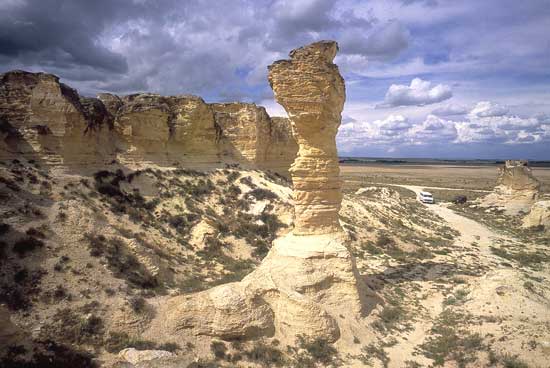A Place to Visit
Cobra Rock
![]()
Gove County,
Kansas

Among the state’s most distinctive geologic features are the chalk monoliths of Gove County. This slender spire—geologists call it a hoodoo—is Cobra Rock. It’s located in the chalk badlands south of Castle Rock, a landmark on the old Butterfield Overland Despatch stagecoach route. Sculpted by erosion, these formations are part of the Smoky Hill Chalk Member of the Niobrara Chalk. The Smoky Hill was the focus of great paleontological activity in the late 1800’s, producing fossils of sharks, turtles, fish, mosasaurs (large swimming reptiles), and pterosaurs. These fossils were deposited at the bottom of the large inland sea that covered most of western North America during the Cretaceous (about 80 million years ago). To get to Cobra Rock, take the Quinter exit off Interstate-70 and head south for 14 miles on Castle Rock Road. Visitors should bear in mind that this is private property. Photo by John Charlton.

Kansas Geological Survey
1930 Constant Avenue, Campus West
Lawrence, Kansas
66047-3726
(785) 864-3965
- John Prather, Chairman, El Dorado
-
Tom Collinson, Pittsburg
-
Dyan Conway, Prairie Village
-
Robert Crangle, Lincoln
- John L. Havlin, Manhattan
- David J. Heinemann, Topeka
- Gary Hulett, Hays
- Jeffrey Mason, Goodland
-
Stephen Morris, Hugoton
-
David Nance, Pittsburg
-
Marvin Odgers, Sublette
-
Richard D. Smith, Wichita
-
William W. Hambleton, Emeritus Member, Lawrence
-
A. Scott Ritchie, KU Geology Assoc. Rep., Wichita
Director: Lee C. Gerhard
The mission of the Kansas Geological Survey, operated by the University of Kansas in connection with its research and service program, is to conduct geological studies and research and to collect, correlate, preserve, and disseminate information leading to a better understanding of the geology of Kansas, with special emphasis on natural resources of economic value, water quality and quantity, and geologic hazards.
The Geology Extension program furthers the mission of the KGS by developing materials, projects, and services that communicate information about the geology of Kansas, the state's earth resources, and the products of the Kansas Geological Survey to the people of the state
Online February 10, 2003
Comments to: lbrosius@kgs.ku.edu
Kansas Geological Survey
URL:http://www.kgs.ku.edu/Publications/GeoRecord/1996/vol2.2/Page4.html